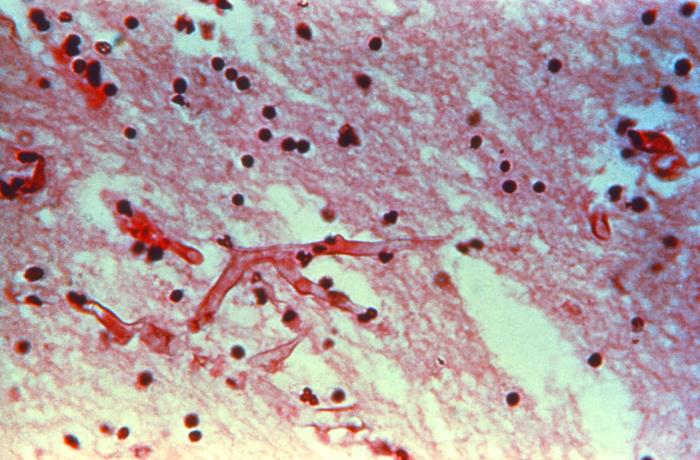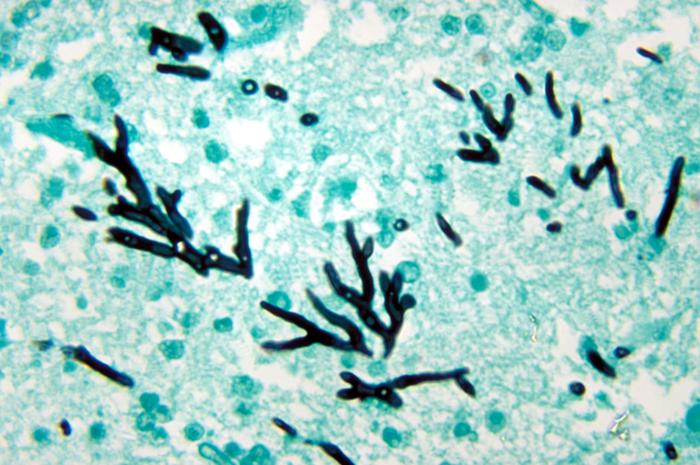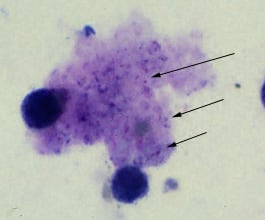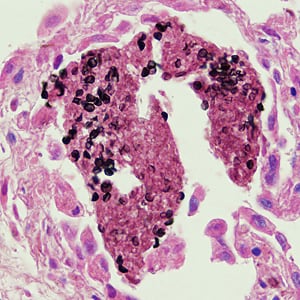These fungi form broad, non septate hyphae with wide angled branching. They are especially associated with infections in diabetic patients and they are known to invade tissues and cause necrosis. They proliferate in the blood vessels. Rhizopus is more commonly implicated than Mucor species. Invasion of the nasal sinuses is most common. It presents as facial pain, blood stained nasal discharge and proptosis. It may cause lung infarctions from blockage of blood vessels. Black eschar like necrotic skin lesions may be seen in burn patients and diabetics. Diagnosis is made by microscopy and biopsy showing typical morphology.

Hematoxylin-eosin ((H&E)-stained specimen, revealed the presence of mycelial fungal filaments in this tissue sample, from a patient ill with mucormycosis (phycomycosis), otherwise known as a form of zygomycosis.
It is a common fungal infection. Aspergillus fumigatus is the most common pathogen in this group. They cause some interesting pathology as follows:
Apart from above, Aspergillus can cause sinusitis, onychomycosis, meningoencephalitis, otomycosis and endocarditis.
Laboratory diagnosis of Aspergillosis: KOH smears and biopsy samples will show characteristic septate hyphae with parallel sides and acute angle, dichotomous branching. Antibody detection and PCR can be used in some cases. Skin hypersensitivity test will be positive in ABPA.

It used to be classified as a protozoan but has now been categorised as a fungi. It causes infections in immunocompromised individuals like HIV positive persons, organ transplant recipients, patients undergoing chemotherapy etc. Infection is acquired by inhalation. It causes interstitial pneumonia presenting with fever, cough, dyspnea, chest pain etc.
Samples are sputum, bronchoalveolar lavage fluid, etc. A variety of histochemical stains have been used to detect Pneumocystis in clinical specimens. These histochemical stains include the Diff-Quik, Grocott-Gomori methenamine silver (GMS) and Calcofluor white stains. GMS is a silver stain while calcofluor is a fluorescent method. Immunofluorescence stains, which employ antibodies directed against P. jiroveci, are also available for the direct detection of this organism in clinical specimens. Samples show numerous cysts which appear as crushed ping-pong balls or crescent shapes or folded spheres or flattened beach balls or deflated tennis balls.

Trophozoites of P. jirovecii in a bronchoalveolar lavage (BAL) specimen from an AIDS patient, stained with Giemsa.

Cysts of P. jirovecii in lung tissue, stained with methenamine silver and hematoxylin and eosin (H&E). The walls of the cysts are stained black; the intracystic bodies are not visible with this stain.
PCR and a blood test to detect beta D Glucan present in the cell wall of P.jiroveci can be used for diagnosis. β-d-Glucan test is used in the presumptive diagnosis of invasive fungal infections such as Candida spp., Aspergillus spp., and Pneumocystis jirovecii. It is non-invasive but drawback is the common occurrence of false positive results. This test cannot be employed in the diagnosis of Cryptococcosis, Zygomycetes and Blastomyces dermatitidis.
Sign up for free to take 3 quiz questions on this topic